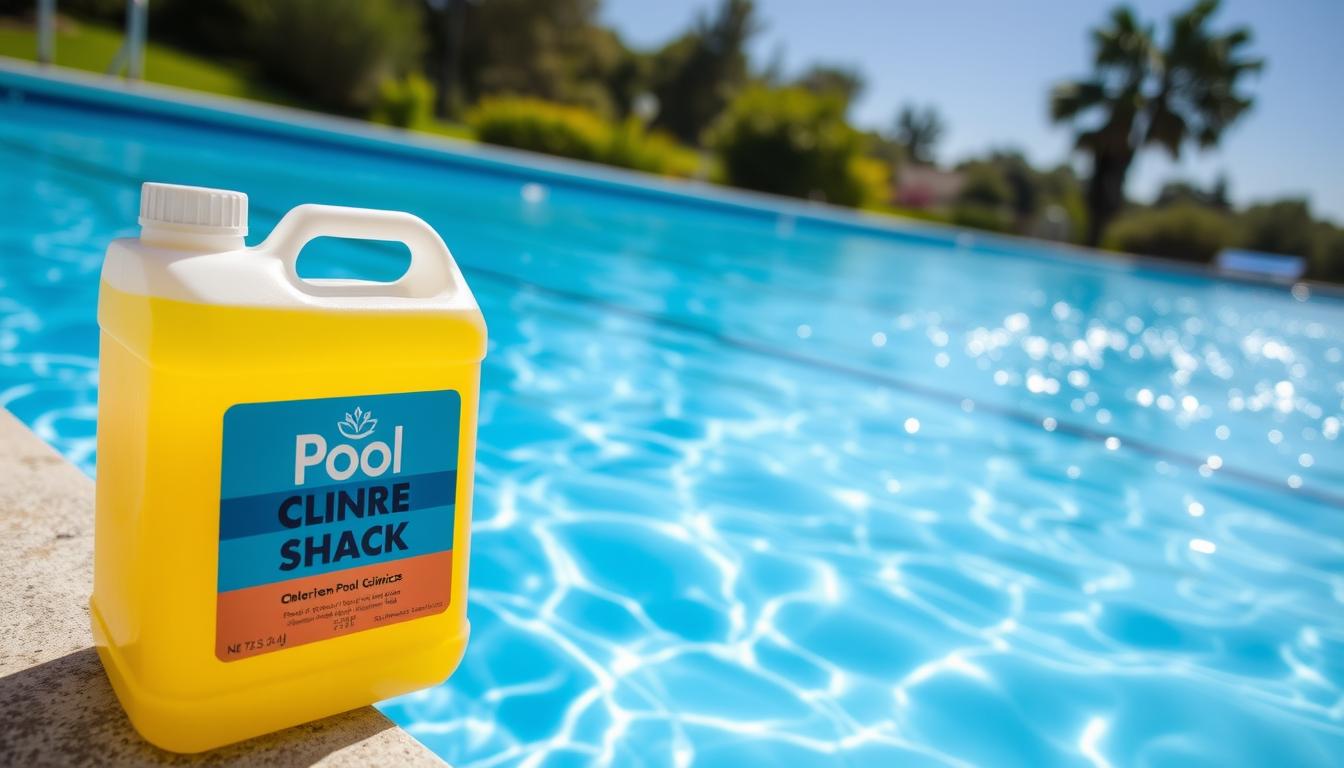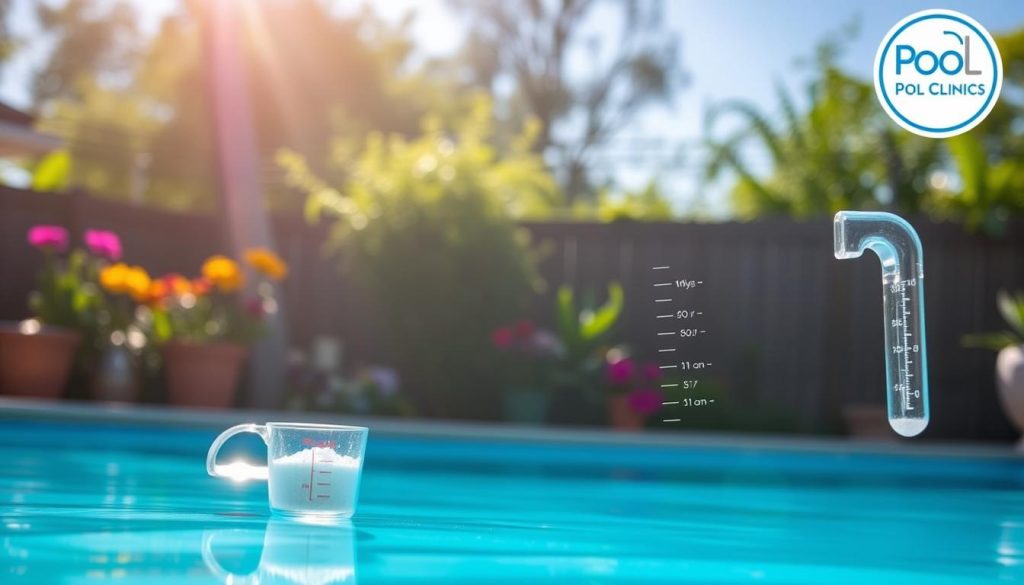
Curious about the right amount of chlorine for pool shocking? Proper chlorine levels keep your pool clean and safe. Factors like pool size and water quality affect chlorine dosage.
This guide offers expert advice on calculating the perfect chlorine amount for your pool. We’ll explore pool shock and help you determine the ideal dosage.
Pool shocking is a crucial part of regular maintenance. It involves adding high chlorine levels to eliminate bacteria and contaminants. Shock your pool when opening or closing for the season.
Also shock after heavy use, rainfall, or when dealing with cloudy water. The frequency depends on pool usage, weather, and overall water quality.
Key Takeaways
- Shocking your pool is essential for maintaining clean and safe water
- The amount of chlorine needed to shock your pool depends on factors like pool size and water quality
- Different types of pool shock contain varying levels of available chlorine
- As a general guideline, use one pound of shock per 10,000 gallons of water
- Always follow safety precautions and manufacturer instructions when handling pool shock
Understanding Pool Shock and Its Importance
Pool shock is vital for clean, healthy swimming pools. It eliminates contaminants, prevents algae growth, and keeps water safe. Let’s explore pool shock basics and its benefits.
We’ll also look at various types. This will help you determine the ideal chlorine demand for pool shock.

What is Pool Shock?
Pool shock is concentrated chlorine or oxidizing agents. It’s added to pool water to boost chlorine levels briefly. This process breaks down organic matter and kills bacteria and algae.
It also removes chloramines that cause irritation and odors. The recommended chlorine level in pools is 1.0 to 4.0 ppm.
Benefits of Shocking Your Pool
Regular pool shock treatments offer many benefits. They maintain a healthy and inviting swimming environment.
- Eliminates contaminants and organic matter, such as sweat, oils, and urine
- Kills bacteria and prevents algae growth
- Removes chloramines, which can cause eye and skin irritation and produce unpleasant odors
- Restores the clarity of the water, preventing cloudy or murky conditions
- Enhances the efficiency of free chlorine, the active form of pool sanitizer
Shock your pool weekly if used often, or every two weeks if not. Proper chlorine shock dosage is crucial for optimal water quality.
Types of Pool Shock
There are three main types of pool shock. Each has its own advantages:
- Calcium Hypochlorite (Cal-Hypo): This is the most common and cost-effective type of pool shock. It has a high chlorine content (around 65%) and dissolves easily in water. Cal-Hypo is ideal for regular maintenance and addressing moderate chlorine demand for pool shock.
- Dichlor (Dichloroisocyanuric Acid): Dichlor shock contains around 50% chlorine and dissolves rapidly, making it perfect for quick shock treatments. It also has built-in stabilizers to protect chlorine from UV degradation, making it suitable for outdoor pools.
- Non-Chlorine Shock (Potassium Monopersulfate): This type of shock oxidizes contaminants without adding chlorine to the water. It’s an excellent option for those with chlorine sensitivities or for treating pools with high combined chlorine levels. Non-chlorine shock treatments, like monopersulfate (MPS), can oxidize waste materials without affecting chlorine levels, reducing the formation of chloramines.
Understanding different pool shock types helps you choose the best option. Consider your pool’s unique needs when selecting a shock treatment.
Proper chlorine shock dosage ensures optimal water quality. Choose the right type for your pool’s specific requirements.
How Much Chlorine to Shock Pool
Shocking your pool with chlorine keeps it clean and healthy. Let’s explore how to determine the right amount of chlorine for your pool. We’ll cover factors affecting dosage and provide a guide for safe pool shocking.
Factors Affecting Chlorine Dosage
Several factors influence the amount of chlorine needed for effective pool shocking. These include pool size, current chlorine levels, and severity of pool issues. The type of shock product used also affects the required dosage.
Calculating the Right Amount of Shock
Experts suggest one pound of shock per 10,000 gallons of pool water. This may vary based on your pool’s specific needs. To find the exact amount, follow these steps:
- Calculate your pool’s volume in gallons based on its shape and dimensions (rectangular, circular, or oval).
- Test your pool water to determine the current chlorine levels and other chemical parameters, such as pH and total alkalinity.
- Consult the packaging of your chosen shock product for specific dosage instructions based on your pool’s volume and current chlorine levels.
The table below offers a general guide for sodium hypochlorite or granules needed. It shows amounts for 6 ppm or 10 ppm chlorine increase in different pool sizes:
| Pool Size (Gallons) | 6 ppm Chlorine Increase (Sodium Hypochlorite) | 10 ppm Chlorine Increase (Granules) |
|---|---|---|
| 5,000 | 0.5 lb | 0.3 lb |
| 10,000 | 1.0 lb | 0.6 lb |
| 15,000 | 1.5 lb | 0.9 lb |
| 20,000 | 2.0 lb | 1.2 lb |
Step-by-Step Guide to Shocking Your Pool
After determining the right amount of chlorine shock, follow these steps for effective pool shocking:
- Ensure your pool’s water level is correct and the filtration system is running properly.
- Test your pool water chemistry, including pH, total alkalinity, and cyanuric acid (CYA) levels. Adjust these levels if necessary to ensure optimal chlorine effectiveness.
- Prepare the shock treatment according to the manufacturer’s instructions, typically by dissolving the shock in a bucket of water.
- Add the shock solution evenly around the pool’s perimeter, avoiding areas with poor circulation or direct contact with pool surfaces.
- Allow the filtration system to run continuously for at least 24 hours to circulate the shock throughout the pool.
- Retest your pool water after 24 hours to ensure the chlorine levels have returned to the ideal range (1-3 ppm) before allowing swimmers back into the pool.
Safety Precautions When Handling Pool Shock
Handling pool shock can be dangerous without proper safety measures. Always wear protective gear like gloves and goggles. Never mix different pool chemicals to avoid dangerous reactions.
Add shock to water, not water to shock, to prevent splashing. Follow the manufacturer’s instructions carefully and avoid over-shocking your pool. Keep children and pets away during the shocking process.
Store pool chemicals in a cool, dry place out of reach. Dispose of empty containers according to local rules. These precautions ensure safe and effective pool maintenance.
Conclusion
Knowing the right amount of chlorine for pool shock is key. It ensures a clean, healthy swimming environment. Following proper dosage advice and maintenance practices keeps pools safe and inviting.
Consider pool size, water chemistry, and shock type when adding chlorine. Regular testing and consistent shocking prevent contaminant buildup. Always follow safety guidelines when handling pool chemicals.
Allow time for chlorine levels to stabilize before swimming. Stay informed about pool care best practices. Work with trusted professionals when needed.
With the right knowledge, maintaining a clean pool becomes simple. This ensures years of enjoyment from your backyard oasis. Create endless hours of summer fun with a sparkling pool.







